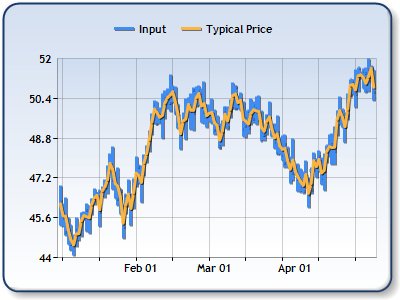Overview

Typical price is the average value of daily prices, and can be used as a filter to help identify trends. It is also used as a daily average price which is very useful if you want a more simple view of prices.
 Note Note |
|---|
| We recommend that you read Using Financial Formulas before proceeding any further. Using Financial Formulas provides a detailed explanation on how to use formulas, and also explains the various options available to you when applying a formula. |
 |
|
Figure 1: This chart shows the Typical Price and a Stock chart. |
Applying a Typical Price
All financial formulas are calculated using the FormulaFinancialmethod, which accepts the following types of arguments: a formula name; input value(s); output value(s), and parameter(s) that are specific to the type of formula being applied.
Also, before applying the FormulaFinancial method, make sure that all data points have their XValue property set, and that their series' XValueIndexedproperty has been set to false.
The following table indicates what sort of FormulaFinancial method arguments to use when calculating a Typical Price, and also supplies a description of what these parameters mean:
| Parameter |
Value/Description |
Example |
|---|---|---|
| Formula Name: |
TypicalPrice
|
FormulaFinancial(FinancialFormula.TypicalPrice,"Series1:Y,Series1:Y2,Series1:Y4","Series2:Y") |
| Input Values: | Value #1: Value which represents the High price. By default this is the first Y value in the stock chart.
Value #2 : Value which represents the Low price. By default this is the second Y value in the stock chart. Value #3 : Value which represents the Close price. By default this is the fourth Y value in the stock chart. |
FormulaFinancial(FinancialFormula.TypicalPrice,"Series1:Y,Series1:Y2,Series1:Y4","Series2:Y") |
| Output Value: (optional) |
The Typical Price. If not specified output is stored in the first input value. |
FormulaFinancial(FinancialFormula.TypicalPrice,"Series1:Y,Series1:Y2,Series1:Y4"," Series2:Y") |
|
Parameter: |
- |
- |
A line chart is a good choice when displaying a typical price series.
Financial interpretation:
This indicator is a good solution if we want to exchange a stock chart with a single line chart, and the indicator will merely calculate the daily average of Hi, Low and Close prices.
Calculation: The Typical price is calculated using the following formula:
![]()
Typical price is a daily average of high, low and close prices.
Example
This example demonstrates how to calculate the Typical price.
| Visual Basic |  Copy Code Copy Code |
|---|---|
| |
| C# |  Copy Code Copy Code |
|---|---|
| |




